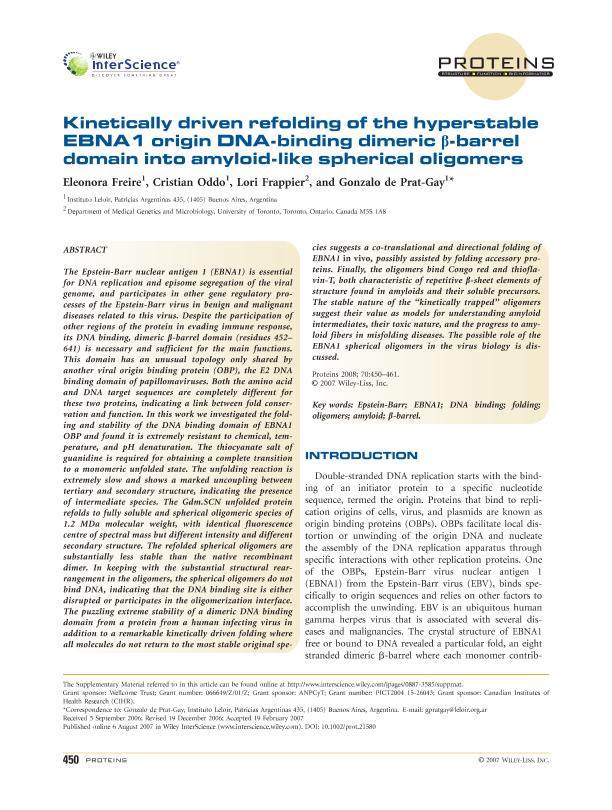Mostrar el registro sencillo del ítem
dc.contributor.author
Freire Espeleta, Eleonora

dc.contributor.author
Oddo, Cristian
dc.contributor.author
Frappier, Lory
dc.contributor.author
de Prat Gay, Gonzalo

dc.date.available
2017-11-21T15:12:16Z
dc.date.issued
2008-02
dc.identifier.citation
Freire Espeleta, Eleonora; Oddo, Cristian; Frappier, Lory; de Prat Gay, Gonzalo; Kinetically driven refolding of the hyperstable EBNA1 origin DNA-binding dimeric beta-barrel domain into amyloid-like spherical oligomers; Wiley; Proteins: Structure, Function And Genetics; 70; 2; 2-2008; 450-461
dc.identifier.issn
0887-3585
dc.identifier.uri
http://hdl.handle.net/11336/28599
dc.description.abstract
The Epstein-Barr nuclear antigen 1 (EBNA1) is essential for DNA replication and episome segregation of the viral genome, and participates in other gene regulatory processes of the Epstein-Barr virus in benign and malignant diseases related to this virus. Despite the participation of other regions of the protein in evading immune response, its DNA binding, dimeric beta-barrel domain (residues 452-641) is necessary and sufficient for the main functions. This domain has an unusual topology only shared by another viral origin binding protein (OBP), the E2 DNA binding domain of papillomaviruses. Both the amino acid and DNA target sequences are completely different for these two proteins, indicating a link between fold conservation and function. In this work we investigated the folding and stability of the DNA binding domain of EBNA1 OBP and found it is extremely resistant to chemical, temperature, and pH denaturation. The thiocyanate salt of guanidine is required for obtaining a complete transition to a monomeric unfolded state. The unfolding reaction is extremely slow and shows a marked uncoupling between tertiary and secondary structure, indicating the presence of intermediate species. The Gdm.SCN unfolded protein refolds to fully soluble and spherical oligomeric species of 1.2 MDa molecular weight, with identical fluorescence centre of spectral mass but different intensity and different secondary structure. The refolded spherical oligomers are substantially less stable than the native recombinant dimer. In keeping with the substantial structural rearrangement in the oligomers, the spherical oligomers do not bind DNA, indicating that the DNA binding site is either disrupted or participates in the oligomerization interface. The puzzling extreme stability of a dimeric DNA binding domain from a protein from a human infecting virus in addition to a remarkable kinetically driven folding where all molecules do not return to the most stable original species suggests a co-translational and directional folding of EBNA1 in vivo, possibly assisted by folding accessory proteins. Finally, the oligomers bind Congo red and thioflavin-T, both characteristic of repetitive beta-sheet elements of structure found in amyloids and their soluble precursors. The stable nature of the "kinetically trapped" oligomers suggest their value as models for understanding amyloid intermediates, their toxic nature, and the progress to amyloid fibers in misfolding diseases. The possible role of the EBNA1 spherical oligomers in the virus biology is discussed
dc.format
application/pdf
dc.language.iso
eng
dc.publisher
Wiley

dc.rights
info:eu-repo/semantics/openAccess
dc.rights.uri
https://creativecommons.org/licenses/by-nc-sa/2.5/ar/
dc.subject
Protein-Dna
dc.subject
Folding
dc.subject
Ebna
dc.subject
Epstein Barr Virus
dc.subject
Cancer
dc.subject
Dna Replication
dc.subject.classification
Otras Ciencias Químicas

dc.subject.classification
Ciencias Químicas

dc.subject.classification
CIENCIAS NATURALES Y EXACTAS

dc.title
Kinetically driven refolding of the hyperstable EBNA1 origin DNA-binding dimeric beta-barrel domain into amyloid-like spherical oligomers
dc.type
info:eu-repo/semantics/article
dc.type
info:ar-repo/semantics/artículo
dc.type
info:eu-repo/semantics/publishedVersion
dc.date.updated
2017-11-16T15:08:15Z
dc.identifier.eissn
1097-0134
dc.journal.volume
70
dc.journal.number
2
dc.journal.pagination
450-461
dc.journal.pais
Estados Unidos

dc.journal.ciudad
Hoboken
dc.description.fil
Fil: Freire Espeleta, Eleonora. Consejo Nacional de Investigaciones Científicas y Técnicas. Oficina de Coordinación Administrativa Parque Centenario. Instituto de Investigaciones Bioquímicas de Buenos Aires. Fundación Instituto Leloir. Instituto de Investigaciones Bioquímicas de Buenos Aires; Argentina
dc.description.fil
Fil: Oddo, Cristian. Consejo Nacional de Investigaciones Científicas y Técnicas. Oficina de Coordinación Administrativa Parque Centenario. Instituto de Investigaciones Bioquímicas de Buenos Aires. Fundación Instituto Leloir. Instituto de Investigaciones Bioquímicas de Buenos Aires; Argentina
dc.description.fil
Fil: Frappier, Lory. University of Toronto; Canadá
dc.description.fil
Fil: de Prat Gay, Gonzalo. Consejo Nacional de Investigaciones Científicas y Técnicas. Oficina de Coordinación Administrativa Parque Centenario. Instituto de Investigaciones Bioquímicas de Buenos Aires. Fundación Instituto Leloir. Instituto de Investigaciones Bioquímicas de Buenos Aires; Argentina
dc.journal.title
Proteins: Structure, Function And Genetics

dc.relation.alternativeid
info:eu-repo/semantics/altIdentifier/url/http://onlinelibrary.wiley.com/doi/10.1002/prot.21580
dc.relation.alternativeid
info:eu-repo/semantics/altIdentifier/doi/https://doi.org/10.1002/prot.21580
Archivos asociados
